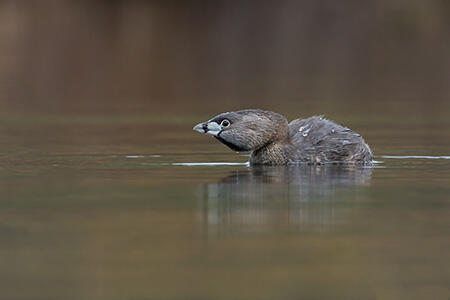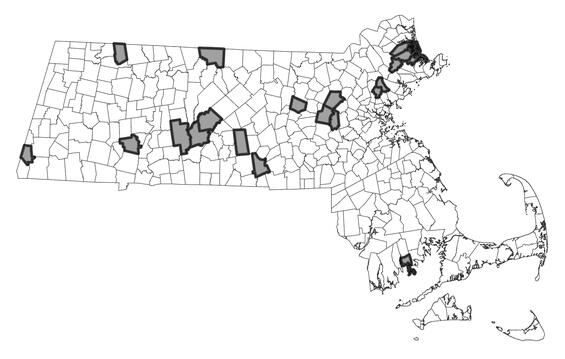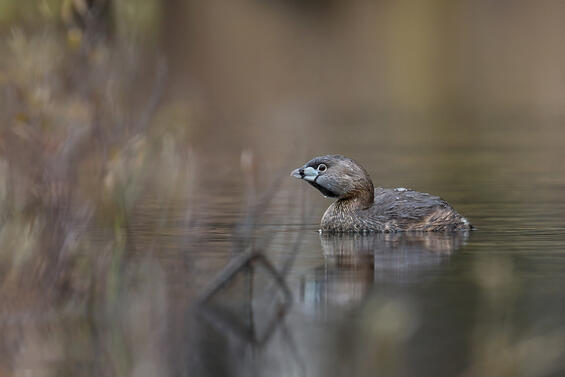- Scientific name: Podilymbus podiceps
- Species of Greatest Conservation Need (MA State Wildlife Action Plan)
- Endangered (MA Endangered Species Act)
Description

Pied-billed grebes are stocky waterbirds, 30-38 cm (12-15 in) in length, with short legs far back on the body, short wings, a short tail, flat lobes on the toes, and a stout, thick, chicken-like bill. The plumage of the pied-billed grebe changes with the seasons. During the summer, the bird is uniformly brown with a dusky underside, a fluffy white posterior, and a large black patch on the throat; its bill is bluish-white, encircled near the middle by a black band. During the winter, the throat loses its black patch, and the bill becomes yellowish, with no black band. The young are liberally banded with black and white stripes, with a smattering of reddish-brown spots. The call of the pied-billed grebe is only given during the breeding season and resembles a series of "cow cow cow" sounds. They are poor fliers and must run across the water for several yards before becoming airborne; the head is held low during flight. Pied-billed grebes can be distinguished from all other grebes by the lack of white wing patches in flight, the chicken-like bill, and, in summer, the black band around the bill.
Life cycle and behavior
Pied-billed grebes arrive in Massachusetts in late March and begin courtship displays, which consist of diving and chasing, bill touching, circling, and calling. This may continue until June, but nesting is usually initiated in late April. The nest is constructed over a period of 3 to 7 days by both the male and female out of decayed reeds, sedges, grasses, and other vegetation. It is normally located in thick vegetation near to or surrounded by open water, which allows the birds to travel to and from the nest underwater and undetected. The territory of the breeding pair usually comprises the area within 46 m (150 ft) of the nest; the pair's home range is about twice this area. Grebes are very shy during the breeding and nesting periods. When alarmed or disturbed, they sink slowly beneath the water and surface again a considerable distance away, often in an area of dense vegetation.
Egg-laying occurs from late April to June; 2 to 10 whitish-blue eggs are laid over a period of several days. The eggs are covered with debris whenever both parents leave the nest, so the egg color gradually changes to a dirty brown. Both parents (but usually the female) incubate the eggs for 23 to 24 days. The chicks are precocial and can swim and dive only hours after emerging from their shells, but they tire quickly. They often climb onto their parents' backs regardless of whether they are in the water or on the nest. The chicks follow their parents everywhere, constantly begging for food. They grow rapidly and are capable of flight in less than a month.
Pied-billed grebes eat a variety of foods, including aquatic vegetation, seeds, frogs, tadpoles, fish, aquatic insects, and especially crayfish. Pied-billed grebes begin to migrate south from Massachusetts in September (sometimes late August), and most are gone by the end of December. Considerable numbers of pied-billed grebes from farther north can sometimes be seen in Massachusetts as they migrate south. Pied-billed grebes are infrequently found in Massachusetts in mid-winter.
Population status
The pied-billed grebe is classified as an endangered species in Massachusetts due to the limited amount of suitable wetland habitats and the small population size of the birds.
Distribution and abundance
The pied-billed grebe is the most widespread species of grebe in North America. Pied-billed grebes can be found from southern Canada southward through the U.S., Central America, and South America to Argentina. The northern populations (including those in Massachusetts) migrate in autumn to the northern limit of unfrozen fresh water south to Panama. Some of the birds may be found in saltwater marshes if there is no unfrozen fresh water available.

Distribution in Massachusetts.
1999-2024
Based on records in the Natural Heritage Database.
Habitat
Pied-billed grebes prefer to nest in marshes, lakes, large ponds, and other wetlands which have an abundant supply of cattails, and other vegetation which can provide cover and nesting materials. They spend the winter in open lakes and rivers, estuaries, and tidal creeks, usually to the south of Massachusetts.
Healthy habitats are vital for supporting native wildlife and plants. Explore habitats and learn about conservation and restoration in Massachusetts.

Pied-billed grebe
Threats
Invasion of wetlands by Phragmites are the primary modern threat to breeding pied-billed grebes in Massachusetts. Wakes from boats and jet skis may swamp nests. Climate change is negatively impacting wetlands, marshes, ponds and rivers through changes to hydrology and warming temperatures. Estuarine habitats are negatively impacted by sea level rise.
Conservation
Maintaining integrity in breeding wetlands is key; especially controlling invasive species. Pied-billed grebes are also sensitive to disturbance, and therefore all development should be sited away from breeding areas and the use of machinery should be avoided around breeding sites during the breeding season.
Contact
| Date published: | April 4, 2025 |
|---|